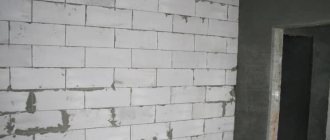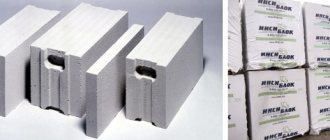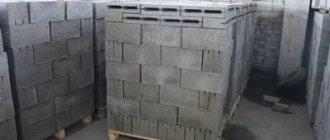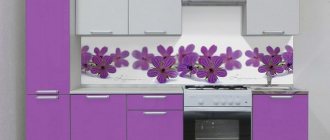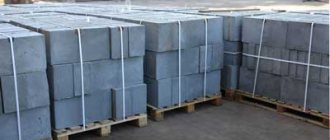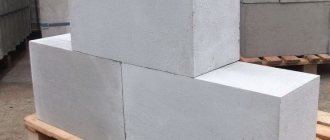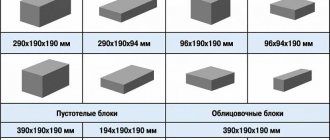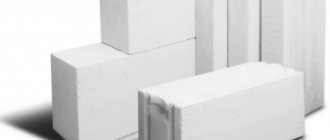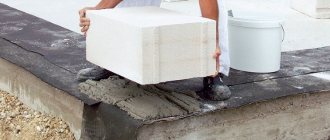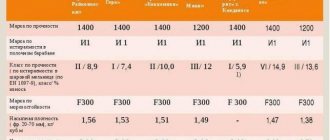The question of how many aerated concrete blocks are in 1m3 is relevant for everyone who is going to use this material in repair and construction work. Aerated concrete is becoming increasingly popular every year, due to its many advantages, being the most optimal choice for the construction of low-rise buildings.
The main advantages of aerated concrete are its low weight and ideal geometry, large size and the ability to quickly build a house with your own hands due to easy and simple installation, a high level of heat conservation and a wide variety of blocks in the assortment. Before starting construction, it is very important to calculate how many blocks are included in the cube and how much material is needed to complete all the work.
The standard size of an aerated concrete block is 60x30x20 centimeters, but manufacturers offer many other dimensions, so before making calculations, you need to decide on the size of the block. Next, they calculate how much material is needed for the construction of all structures (internal partitions and load-bearing walls) in cubic meters, calculate the number of blocks in 1 cubic meter, calculate the required quantity and, taking into account information about the capacity of the pallet, obtain the required value - the exact volume of building material.
How many gas blocks are there in 1m3
To calculate how many gas blocks are in one cube, you need to know the exact dimensions of one unit. This information is indicated among the first in specifications and product descriptions, so after choosing a supplier and the optimal dimensions for the blocks, it will not be difficult to calculate everything.
The blocks come in the following sizes (the most popular): 60x30x20 centimeters, 25x30x60, 60x40x25 centimeters and 32.5x20x25. Typically, large blocks are chosen for laying load-bearing walls; for internal walls, blocks 10-20 centimeters wide are sufficient.
Before the calculations begin, all millimeters/centimeters are converted into a single measurement system - into meters: to obtain values when indicated by the manufacturer, millimeters must be divided by 1000, centimeters - by 100. Thus, the sides of a block of 600x300x200 millimeters or 60x30x20 centimeters will be equal to 0.6x0.3x0. 2 in meters.
Now you need to find out how much volume is equal to one gas block: multiply all sides by 0.6x0.3x0.2, it turns out 0.036. This is exactly how much volume one standard size block can hold. Now 1 cubic meter needs to be divided by 0.036 - and the number of blocks in 1 cube is obtained: 1/0.036=27.7=28. This means that one cubic meter contains 28 blocks of standard size 60x30x20 centimeters.
To understand how to use this in practice, you can consider an example of calculating the number of blocks in cubic meters for one house.
It is difficult to calculate how many blocks are needed to build a wall using the exact dimensions of the material. It is much easier to calculate the required volume in cubic meters, and then count the number of blocks.
An example of calculating gas blocks for a house:
- Initial data
– box 4 by 6 meters, height 3 meters. 3 windows measuring 1.5x1.5 meters and a door 2x1 meter will be installed. The thickness of the walls is 30 centimeters (0.3 meters).
- Calculating the volume of walls
– (6+4+6+4)x3x0.3=18 cubic meters.
- Accounting for windows and doors
– (1.5+1.5)x3x0.3=2.7 (windows), 2+1=3x0.3=0.9 (door). It turns out 2.7+0.9=3.6.
- Volume of material
– 18 – 3.6 = 14.4 cubic meters.
- It was calculated above that 28 standard size aerated concrete blocks fit in one cubic meter - which means that for 14.4 cubic meters you need: 14.4x28 = 403 blocks.
How many gas blocks 20x30x60 in 1 cubic meter
The calculation algorithm was presented above and they are quite simple if you think about the essence and understand what is being done and why.
How to calculate the number of gas blocks 20x30x60 centimeters per cubic meter:
- To obtain the desired value, you first need to find out how many cubic meters fit in one gas block. To do this, all sides of the block, converted to a single value (meters), are multiplied: 0.6x0.3x0.2 = 0.036 gas blocks in one cubic meter.
- Now you can find out how many blocks are included in 1 cubic meter: for this, the number of meters (1) is divided by the volume occupied by one block (0.036) - it turns out 27.7, roughly speaking, 28 pieces.
If the dimensions of aerated concrete are different, the corresponding values are substituted. To make the calculations more clear, you can create simple formulas.
Finding the volume occupied by a block:
height x width x length = volume of one block
.
Finding the number of blocks in 1 m3:
1 / volume of one block = number of gas blocks per cubic meter
.
How many aerated concrete blocks in 1 m3 in a pallet?
To calculate how many blocks fit on a pallet, you need to know exactly the dimensions of the blocks and the size of the pallet. As a rule, a pallet holds 40-180 blocks, depending on their size. But pallets can also be different, so usually when ordering material, this parameter is obtained from the manager. Knowing how many pieces of aerated concrete a pallet can hold, they indicate their number, and can also understand whether it will be possible to deliver aerated concrete in one transport trip.
On the other hand, cubic meters are usually used to calculate the number of gas blocks needed for work. The same indicator is indicated when ordering material, and the buyer is not particularly concerned about the number of pallets. But if you want to organize the delivery of gas blocks to the site yourself, it happens that you need to know the number of pieces on the pallet.
The table below shows the number of blocks of different sizes on pallets:
Production of material without an autoclave
The second method does not use an autoclave, so the blocks take longer to harden. This method is rarely used, since the material will be less durable. After complete hardening, the large element is cut into several small ones, observing the standards. From gas silicate blocks it is possible to build multi-storey residential buildings, industrial buildings, dachas, garages, utility and workshop buildings, and large complexes for keeping animals. Since the blocks are universal, they can be used to build various types of walls, load-bearing, and ordinary elements, as well as for partitions.
Weight
The weight of an aerated block, just like its size, can be very different and depends not only on the dimensions, but also on the density. The higher the density of concrete, the more it weighs.
Types of aerated concrete by weight and density:
- The lightest
– they have many pores, the density is minimal, the material is usually used as insulation; it is not suitable for laying walls due to its low strength. The mass of such blocks is 200-500 kilograms per cubic meter.
- Heavy aerated blocks
- the most common option. A cubic meter weighs up to 500-900 kilograms. These blocks are ideal for constructing walls of low-rise buildings.
- Extra-heavy gas blocks
– 900-1200 kilograms per cubic meter. Such blocks are used in high-rise construction; they are considered the most durable and dense, but also the heaviest.
In order not to make a mistake when choosing a material, just look at its brand - it corresponds to the density, the number of kilograms per cubic meter. Thus, the brand of aerated block D400 indicates that the density of the material is 400 kg/m3, D600 – 600 kg/m3, etc.
The main advantages of the gas silicate block
- This type of material has little weight, which makes it possible to reduce the load on the foundation.
- The high strength of the blocks allows for increased service life.
- The material also has high thermal insulation and sound insulation.
- Fire resistance, and therefore fire safety, is one of the main characteristics.
- Aerated blocks are resistant to frost, do not emit harmful substances, that is, the material is environmentally friendly.
- Thanks to precise dimensions, you can get an even structure without deviations.
- Assembly and installation of blocks is simple and fast.
- Low cost makes the material available for any construction. At the same time, buildings made from this material are not prone to destruction.
- The vapor permeability rate is high. And the thickness of the connecting seams is minimal.
Due to the fact that voids are evenly distributed inside the block, the strength indicator increases. The cells of the material are ordered, this creates low thermal conductivity, and additional insulation is not required; it is enough to simply plaster the outer surface.
Aerated blocks can be used as a thermal insulation material for old buildings; for this purpose, material with a low density is used. They also serve as high-quality sound insulation. Thanks to the components included in the composition, the blocks are non-flammable, have a high vapor permeability rate, and do not contain toxic elements. When performing construction work, ventilation ducts and heating are simplified, and subsequently a comfortable microclimate is created in the room.
Gas silicate blocks are laid using a special adhesive composition, which creates the smallest joint thickness, which contributes to high-quality thermal insulation of the building. Light weight makes it easy to transport and unload gas silicate material.
Due to the light weight, minimal load is placed on the foundation, so the base does not have to be bulky, this also helps to save money on costs. That is, when using this type of material, construction work and the creation of a project are simplified. Construction is carried out quickly and simply, without special knowledge or experience. The main disadvantage of blocks is that moisture quickly penetrates into the cells, and when the temperature changes, the blocks are subject to destruction. Therefore, after laying the blocks, the material is immediately finished, which will protect it from external influences. The main condition for installation is to carry out the process in dry weather.
Density
The density of a material, as stated above, is directly related to its weight and strength. The connection is this: the denser the aerated concrete, the higher its strength and weight, and also the lower its heat-saving abilities. Therefore, the choice for the master is always difficult: either choose a durable and dense, heavy material (which will complicate installation and make the house less warm), or build from a loose material of low strength, which will be light and provide the best thermal insulation and sound insulation properties.
Aerated concrete blocks are divided into grades, which indicate not just numbers, but density, the number of kilograms of material per cubic meter. D200 brand blocks have a density of 200 kg/m2 - that is, their weight is 200 kilograms per cubic meter.
The density of aerated concrete varies by the volume of the gas-forming agent in the composition of the material. The blocks are made from a mixture of cement, water, sand and aluminum powder. The volume of bubbles in the composition can vary between 20-90%. Air bubbles in the structure directly affect the density and strength - the more of them, the less dense and durable the material, but the higher the heat saving rate.
For the construction of residential buildings with 2-3 floors, aerated concrete with a density of 400-500 kilograms per cubic meter is most often chosen. This is the most optimal ratio of characteristics.
What does mass depend on?
Experienced designers prefer to calculate the weight of aerated concrete blocks at the design stage. This is due to the fact that this characteristic allows you to recognize and correctly distribute the load on the foundation of the building.
Preliminary calculations of indicators help prevent warping or subsidence of walls. In addition, if you know the size and weight of the blocks, you can calculate the costs of materials and their transportation.
The weight of aerated concrete depends on the size, composition of the solution, humidity and density.
Density
The consistency of a building material has a direct impact on its mass. Aerated concrete blocks belong to the category of lightweight concrete - the weight of a cube (1 m³) varies between 500-1800 kg. The fluctuation of the mass depends on the size of the air voids that are formed under the influence of gases.
To divide building blocks into categories based on density, manufacturers carry out labeling, which is regulated at the state level. The indicator is designated by the letter D, and the value is given in kg/m³.
If you need to determine how much a cube weighs. m of aerated concrete products, you just need to look at the brand. For example, the value D400 indicates that the mass of 1 m³ is 400 kg.
There are 9 main varieties:
- 300;
- 400;
- 500;
- 600;
- 700;
- 800;
- 900;
- 1000;
- 1100;
- 1200.
According to the intended purpose, the material can be structural or thermal insulating. It should be remembered that the mass of the first will always be greater than that of the second. The size of the blocks directly affects their weight. It follows from this that with the same composition and density, a material with dimensions of 200x300x600 mm will weigh more than 100x100x300 mm.
Humidity
During the production process, aerated concrete is exposed to saturated steam and high pressure. Therefore, the finished product contains 25-30% moisture of the entire composition, due to which the weight of the aerated block increases by 1.2-1.3 times. During operation, the material loses about 5% moisture.
The composition of concrete-based solutions has a great influence on the mass of finished products. Domestic manufacturers adhere to GOST requirements, so there are no significant differences in the ratio of components.
It is necessary to pay attention to the composition when purchasing imported mixtures. The heaviest component is sand, and its proportions in the composition change the mass of the material.
Options
The sizes of gas blocks can be very different, as well as the shape and design. Blocks for laying walls are usually made in the shape of a large parallelepiped. An example of a standard size is 60 centimeters in length, 30 centimeters in height and 20 in width. Several other standard sizes are also common, but there are also blocks for internal walls (they are smaller), additional elements, and products of special design.
There are two types of gas blocks
For most tasks at construction sites, it is enough to have two types of aerated concrete blocks - conventional rectangular and U-shaped, which are relevant for performing different parts of the structure. In addition, the shape of the blocks can be different.
What types of gas blocks are there by type and shape:
- Rectangular blocks
– used for the construction of internal partitions and external load-bearing walls.
- Reinforced aerated concrete beams
– for creating ceilings. The floors are assembled from T-shaped beams measuring 60x25x20 centimeters, window/door openings are made from U-shaped blocks, which can significantly speed up the installation process and reduce labor costs.
- Arc-shaped gas blocks, lintels
– are used to facilitate the construction process (certain parts of the structure are made from them).
When choosing aerated concrete blocks, it is important to know the production technology of the material. There are two options in total and in general they are similar, but differ in key parameters. The mixture is prepared for pouring into a mold according to the same recipe, but in the case of autoclaved aerated concrete, the solution is poured into one large mold and sent to an autoclave, where it is subjected to high pressure and temperature.
Non-autoclaved aerated concrete is poured into molds and then dried under natural conditions. In this case, the material turns out to be less durable, and there may be chips and peeling on it.
For construction, it is better to choose autoclaved aerated concrete, which may cost more, but demonstrates much higher performance characteristics.
Standard product sizes
The standard block sizes were indicated above (600x300x200 millimeters), and other standard sizes can also be included.
What sizes are usually used:
- Length – from 60 to 62.5 centimeters.
- Height – from 20 to 25 centimeters.
- Width – from 8.5 to 40 centimeters.
Below are the possible options:
U-shaped products are produced with the following parameters
Standard products of this form usually have the following dimensions: 25 centimeters in height, 50-60 centimeters in length and 20-40 centimeters in width. Before purchasing building materials, you must carefully measure everything and calculate how many gas blocks are needed and where. Calculations are carried out according to the same scheme as in the case of conventional gas blocks.
Calculations
To perform calculations and find the required volume of aerated concrete, you first need to correctly calculate the structure. They calculate the height and width of the walls, the dimensions of the entire building, and internal partitions. Then the length of the walls is multiplied by the height and the total area in square meters is obtained. Next, the thickness of the walls is determined and the resulting indicator is multiplied by the thickness in meters (0.2, 0.3, 0.4, which is equal to 20, 30, 40 centimeters, respectively) and the required volume of the gas block in cubic meters is obtained.
After this, you need to find how much cubic volume is per block - multiply all its sides and divide by the resulting figure one. Then it is enough to multiply the number of cubic meters by the number of blocks per cubic meter and get the desired value - the number of pieces of aerated concrete blocks.
Usually, the examples do not take into account the thickness of the seam, so you don’t have to add the classic 7-10% to the resulting figure. The seams can be thin when using special glue or medium thickness if the masonry is carried out using cement-sand mortar.
Despite the fact that a package of glue costs more than an identical volume of masonry mixture, in the end it turns out to save both due to the thickness of the seams and on heating, since the glue does not create cold bridges.
Knowing how many aerated concrete blocks in 1m3 is desirable for everyone who starts construction. Even if all these volumes and figures can be calculated in production or in a store, there will be no doubt about the correctness and correctness of the calculations performed independently.
Advantages and disadvantages of aerated concrete
Aerated concrete blocks often have to be transported over long distances to be delivered to the place of use. The material is not demanding regarding transportation conditions. The advantages of aerated concrete are:
- correct geometric shape, allowing rational placement of material on a pallet and in the cargo compartment of a vehicle;
- high compressive strength, which allows products to be loaded onto pallets in several rows;
- resistance to dynamic influences - shocks, jolts, shaking that inevitably occur during transportation.
The disadvantages of aerated concrete are:
- low tensile strength - bending forces arising from improper loading or in case of insufficient rigidity of the loading platform can destroy the material;
- high ability to absorb moisture harms the material during transportation and storage on open platforms and areas;
- aerated concrete is light in weight, and during transportation it is impossible to transport pallets arranged in two tiers; as a result, a fully loaded vehicle may be underloaded in weight, which makes transportation not always rational, significantly increasing the cost of material for construction.
To reduce external influences on the material during transportation, manufacturers pack products in thick plastic film and secure the pallets with strong tapes. To reduce transportation costs, construction organizations transport material using their own vehicles, without resorting to the services of transport companies.
